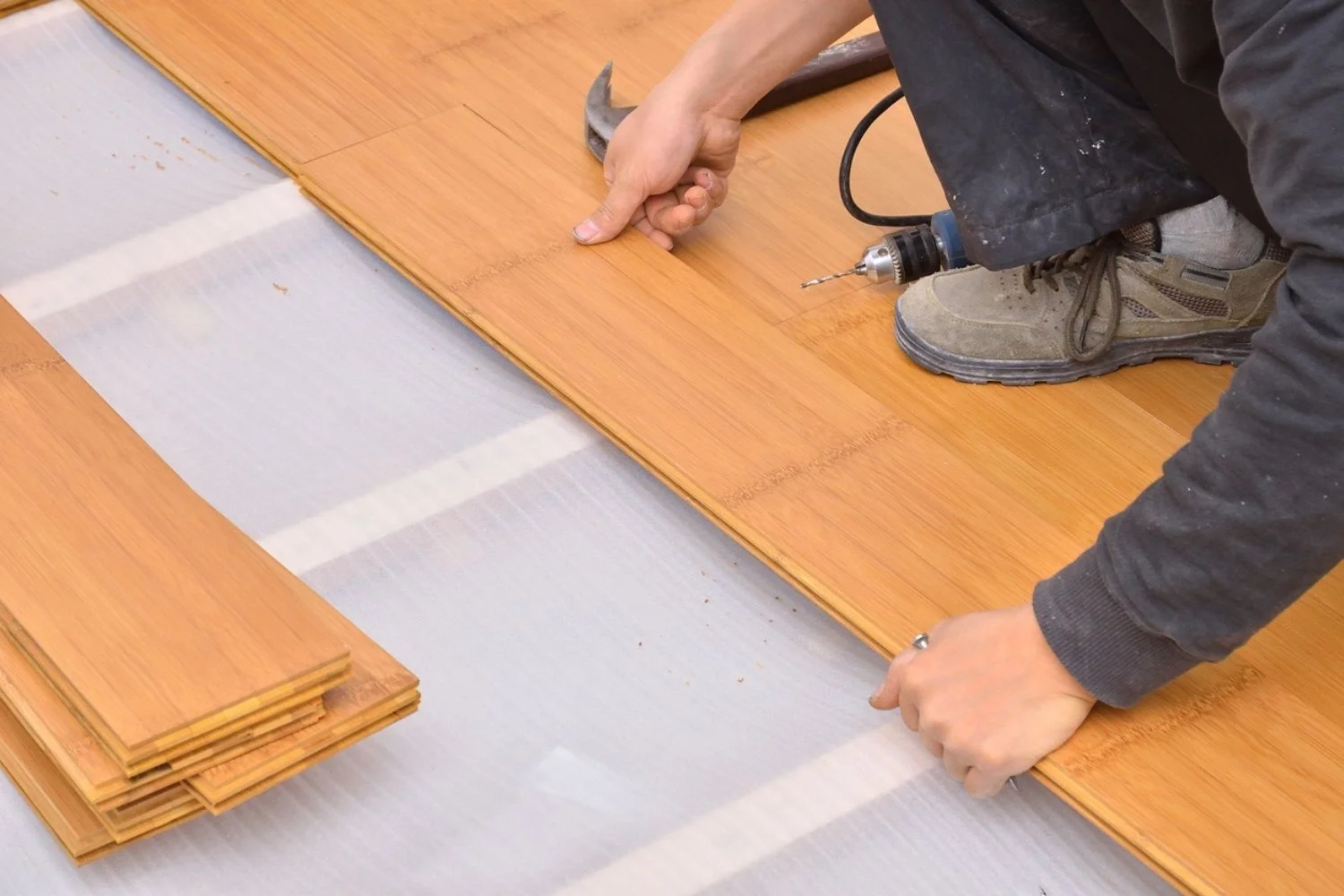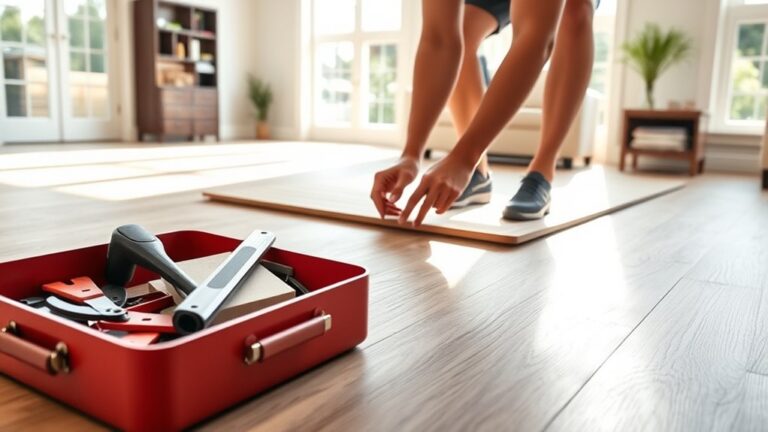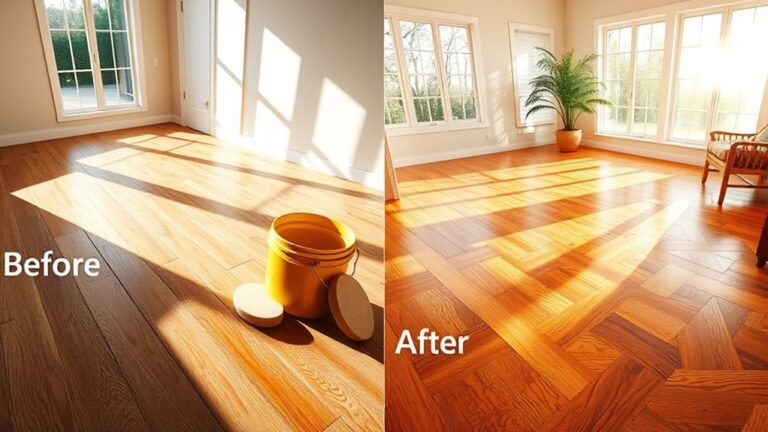To install bamboo wood flooring, follow these steps: measure and prepare the area, acclimate the flooring, lay down a moisture barrier, install the underlayment, click together and nail or glue down the bamboo planks, and finish with baseboards and transition strips. Are you considering installing bamboo wood flooring in your home?
Bamboo is a popular choice for its durability, sustainability, and natural beauty. Whether you’re a DIY enthusiast or hiring a professional, installing bamboo wood flooring can transform your space. However, it’s important to follow the correct installation process to ensure a long-lasting and beautiful result.
In this guide, we’ll walk you through the steps of installing bamboo wood flooring, from measuring the area to finishing touches like baseboards and transition strips. Get ready to enjoy the benefits of this eco-friendly and stylish flooring option.
Gather The Necessary Tools For The Installation
This blog post will guide you on how to install bamboo wood flooring. Before you start, make sure you have the necessary tools:
| Measuring tape | Chalk line | Hammer |
| Nail gun | Saw | Spacers |
| Moisture barrier | Underlayment |
Step 1: Prep the area by removing any existing flooring and ensuring the subfloor is clean and level.
Step 2: Measure the room and calculate the amount of bamboo flooring you will need. Use the measuring tape and chalk line to mark the layout and create guidelines.
Step 3: Lay down the moisture barrier to prevent any damage from moisture seeping through the floor.
Step 4: Install the underlayment to provide a cushioning and sound-proofing layer.
Step 5: Begin laying the bamboo wood flooring, starting from one corner of the room. Use spacers to maintain uniform gaps between planks.
Step 6: Nail or glue the flooring into place using a nail gun or adhesive as per the manufacturer’s instructions.
Step 7: Use a saw to trim the last plank to fit, leaving a small gap for expansion.
Step 8: Once the flooring is installed, remove spacers and add trim to complete the look.
Note: It is important to follow the manufacturer’s instructions and recommendations for your specific bamboo wood flooring.
Assess The Room’s Conditions And Requirements
Before installing bamboo wood flooring, it is crucial to evaluate the room’s conditions and requirements adequately. One of the essential aspects to check is the moisture levels. Excessive moisture can cause damage to the flooring over time. To avoid this, utilize a moisture meter to measure and ensure the moisture content is within the recommended range.
Another crucial step is evaluating the subfloor condition. Ensure that it is clean, dry, and level. Any irregularities may cause problems during installation and affect the overall appearance and durability of the flooring.
Additionally, determining the acclimation period for bamboo flooring is important. This refers to the time required for the flooring to adjust to the room’s temperature and humidity. Follow the manufacturer’s guidelines to determine the length of this period, as it can vary based on various factors, such as the type of bamboo flooring and the room’s conditions.
Step 1: Prepare The Subfloor
Step 1: Prepare the Subfloor
To install bamboo wood flooring, you need to start by preparing the subfloor. The first step is to remove any existing flooring. This can be done by carefully prying up the old flooring material and disposing of it properly.
Once the old flooring has been removed, the next step is to clean and level the subfloor. This is important to ensure a smooth and even surface for the bamboo wood flooring to be installed on. Use a broom or vacuum to remove any dust or debris, and then inspect the subfloor for any uneven areas or dips. If necessary, use a floor leveling compound to fill in any low spots and create a flat surface.
Finally, if the subfloor is in a potentially damp area, it is recommended to install a moisture barrier. This will help to prevent any moisture from seeping up into the bamboo wood flooring and causing damage over time. The moisture barrier can be rolled out and secured to the subfloor using staples or tape.
Step 2: Install The Underlayment
To install bamboo wood flooring, a crucial step is to properly install the underlayment. The underlayment serves as a moisture barrier and helps to reduce noise. Once you have prepared the subfloor, you can start laying out the underlayment. Start by rolling it out across the entire floor, ensuring that it covers the entire area. It is essential to overlap each row of underlayment by a few inches to prevent gaps. Once the underlayment is laid out, you can cut it to size using a utility knife. Make sure to leave a small gap along the edges for expansion. Finally, secure the underlayment to the subfloor by using a staple gun or adhesive. This will ensure a stable base for the bamboo wood flooring installation.
Step 3: Plan The Layout
When installing bamboo wood flooring, it is important to plan the layout before beginning the installation process. Determining the orientation of the flooring and establishing a starting point are two crucial steps in this process.
The orientation of the flooring refers to the direction in which the floorboards will be laid. To determine the best orientation, consider the layout of the room, the natural light sources, and the main entrance. You want to choose an orientation that enhances the overall flow and appearance of the space.
Once you have determined the orientation, it is time to establish a starting point. This point will serve as the reference for the rest of the installation. It is recommended to start in the corner of the room, placing the first row of floorboards against the longest wall. This will provide a solid foundation for the rest of the installation.
By carefully planning the layout and determining the orientation of the bamboo wood flooring, you can ensure a successful and visually appealing installation. Remember to take your time and measure twice before making any cuts or laying down any boards.
Step 4: Install The First Row
To install the first plank of bamboo wood flooring, start by ensuring proper spacing from the walls. Measure and mark the distance from the wall using a tape measure. This will prevent the planks from being too close or too far from the edges. Once marked, carefully place the first plank against the wall, ensuring that it is straight and aligned with the reference line you created earlier.
Secure the plank in place using nails or staples specifically designed for bamboo flooring. This will ensure a secure and sturdy installation. Continue adding planks to complete the first row, making sure to maintain the proper spacing between each plank. Use a rubber mallet to gently tap each plank into place, ensuring a tight fit.
Once the first row is complete, double-check that it is straight and even. This will serve as a foundation for the rest of the bamboo wood flooring installation. Continue the installation process by repeating these steps for the subsequent rows until the entire floor is covered.
Step 5: Continue Installing The Flooring
Step 5 involves continuing the installation process of bamboo wood flooring, following the previous steps. Ensure precise measurements and a smooth, secure placement for a flawless finished result.
Step 5: Continue Installing the Flooring
In the process of installing bamboo wood flooring, after completing the initial row, you will need to install subsequent rows. This entails following the proper techniques for either adhesive or nail-down installation.
For adhesive installation, apply the appropriate adhesive to the subfloor and carefully align the tongue and groove of the bamboo boards before pressing them firmly together. Remember to leave a small expansion gap between the boards and the wall to account for any potential expansion or contraction.
If you opt for nail-down installation, use a pneumatic flooring nailer to secure the bamboo boards to the subfloor. Ensure that the boards are properly aligned and that the nails are driven at the correct angle and depth.
Continue installing the flooring row by row, making sure that each subsequent row is securely connected to the previous one. Take care to stagger the end joints for a more visually appealing and structurally sound result.
By following these instructions, you can successfully install your bamboo wood flooring and achieve a beautiful and durable floor surface.
| Adhesive Installation | Nail-down Installation |
|---|---|
| Apply adhesive to subfloor | Secure boards with a pneumatic flooring nailer |
| Align tongue and groove | Ensure proper alignment |
| Leave an expansion gap | Drive nails at the right angle and depth |
| Stagger end joints |
Step 6: Cut And Fit Around Obstacles
When installing bamboo wood flooring, it’s crucial to properly measure and cut the flooring to fit around obstacles such as doorways and corners. This ensures a professional and seamless finish. To achieve precision cuts, you can use either a jigsaw or a coping saw, depending on your preference and comfort level.
Measure the dimensions of the area that needs to be cut, taking into account any angles or irregularities. Then, use the jigsaw or coping saw to carefully cut along the marked lines. Be sure to wear protective eyewear and gloves for safety.
Test the cut piece against the obstacle and make any necessary adjustments. Repeat this process for all areas where the flooring needs to fit around obstacles. It’s important to take your time and ensure accuracy during this step to achieve a professional-looking installation.
Step 7: Install Transition Pieces
When installing bamboo wood flooring, it is important to include transition pieces to create a seamless look between rooms or different types of flooring. Transition molding is used to bridge the gap between two different surfaces, allowing for a smooth and visually appealing transition.
Choose the appropriate transition molding based on the specific needs of your installation. There are a variety of options available, including T-molding, threshold molding, reducer molding, and stair-nosing molding. Each type is designed to address different scenarios, such as transitioning between different floor heights or between different materials.
Ensure that the transition pieces are properly installed by following the manufacturer’s instructions. This may involve measuring and cutting the molding to the appropriate size, as well as securing it in place with adhesive or nails.
By installing transition pieces, you will not only enhance the overall aesthetics of your bamboo wood flooring installation but also ensure a smooth and professional finish. Take the necessary time to select the right transition molding and properly install it for a polished end result.
Step 8: Complete The Installation And Finishing Touches
After carefully installing the previous rows of bamboo wood flooring, it’s time to move on to the final row. Start by measuring the space left and cut the last row of planks accordingly. Remember to account for any necessary expansion gaps.
To install the final row, place the planks tongue-side towards the wall and secure them in place using a flooring nailer. Be sure to maintain the proper spacing between each plank. Once the final row is in place, trim any excess underlayment and flooring using a utility knife.
With the flooring installed, it’s time for the finishing touches. Inspect the entire floor for any noticeable gaps or imperfections. Fill any gaps with wood filler to ensure a smooth, seamless finish.
Once the floor is visually flawless, it’s time to complete any necessary finishing steps. This may include sanding the floor to remove any rough areas or applying a protective sealant to enhance durability. Follow the manufacturer’s instructions carefully.
Tip 1: Acclimate The Flooring Properly
Properly acclimating the bamboo wood flooring is crucial for a successful installation process. Take the time to allow the flooring to adjust to the temperature and humidity of the room before beginning the installation, ensuring a durable and long-lasting result.
Allow Bamboo Flooring To Adjust To The Room’s Humidity And Temperature
Proper acclimation is crucial for successfully installing bamboo wood flooring. Before you begin installation, ensure that the flooring has adjusted to the room’s humidity and temperature. Bamboo is sensitive to changes in its environment, so it’s important to allow it to acclimate for at least 48 hours.
Start by unboxing the flooring and removing any packaging materials. Place the bamboo planks in the room where they will be installed. Make sure the room is at the desired temperature and humidity level, as this is the environment the flooring will adapt to.
During the acclimation process, avoid exposing the bamboo flooring to extreme temperature changes and direct sunlight. This can cause warping or other damage. Maintain a consistent environment by closing doors and windows and using a humidifier or dehumidifier, if necessary.
By allowing your bamboo wood flooring to acclimate properly, you ensure a more stable and long-lasting installation. This simple step helps minimize the risk of future issues and ensures a beautiful and durable finished floor.
Tip 2: Maintain Proper Moisture Levels
Installing bamboo wood flooring can greatly enhance the aesthetic appeal of your space. To ensure its longevity and maintain its beauty, it is crucial to keep the moisture levels in check. One of the key factors to consider is monitoring and controlling the humidity in the room. Bamboo is highly sensitive to moisture and can expand or contract with changes in humidity. This can lead to gaps and warping of the flooring. To prevent this, consider using a hygrometer to measure the humidity levels regularly. Ideally, the humidity should be maintained between 40% and 60%. If the levels are too high, use a dehumidifier to reduce the moisture. On the other hand, if the levels are too low, use a humidifier to add moisture to the air. By keeping the humidity levels within the recommended range, you can ensure the longevity and durability of your bamboo wood flooring.
Tip 3: Protect The Flooring From Scratches And Dents
When installing bamboo wood flooring, it is important to take steps to protect it from scratches and dents. One way to do this is by placing protective pads under furniture. These pads act as a barrier between the furniture and the floor, preventing any unwanted scratches or dents. Additionally, using area rugs in high-traffic areas can also help to protect the flooring. The rugs provide a layer of cushioning and can absorb the impact of foot traffic, reducing the chances of any damage to the bamboo wood. By following these tips, you can ensure that your bamboo wood flooring stays in great condition for years to come.
Tip 4: Clean And Care For The Bamboo Flooring
To clean and care for your bamboo flooring, there are a few simple steps you can follow:
- Regularly sweep or vacuum the floor to remove dirt and debris. This helps prevent scratching and keeps the surface looking clean.
- For regular cleaning, use a damp mop with a diluted bamboo floor cleaner or a mild soap solution. Avoid using excessive water as it can cause damage to the flooring.
- Avoid using harsh cleaning agents or chemicals on your bamboo flooring as they can strip away the protective finish and cause discoloration.
- If there are any spills or stains, promptly clean them up using a soft, damp cloth. Avoid using abrasive scrubbers or cleaners that may scratch the surface.
- Place mats or rugs at entryways and high-traffic areas to minimize dirt and grit from being tracked onto the floor.
- Trim your pet’s nails regularly to prevent scratches on the bamboo flooring.
By following these care instructions, you can extend the lifespan and maintain the beauty of your bamboo wood flooring.
Tip 5: Address Potential Issues Promptly
One important tip when installing bamboo wood flooring is to address any potential issues promptly. This includes repairing any damage or loose planks that may arise during or after the installation process. It is crucial to take immediate action to prevent further damage or accidents. In some cases, seeking professional help may be necessary to ensure proper repairs are made, especially if the damage is extensive or if you are uncertain about how to fix it yourself. Remember, quick action will not only help maintain the quality and aesthetic appeal of your bamboo flooring but also extend its lifespan.
:max_bytes(150000):strip_icc()/room-divider-GettyImages-1428199297-7ae531964bfb4baab1b1cc013bfc634d.jpg)
Frequently Asked Questions Of How To Install Bamboo Wood Flooring
What Is The Best Way To Install Bamboo Flooring?
To install bamboo flooring, start by measuring and preparing the space. Lay down a moisture barrier, then glue or nail the bamboo planks into place. Finish by trimming the edges and adding baseboards. It’s important to follow the manufacturer’s instructions for the specific type of bamboo flooring being installed.
Should Bamboo Flooring Be Glued Or Nailed?
Bamboo flooring should be glued rather than nailed for better stability and durability. Nailing can cause the bamboo to split, while gluing ensures a secure and long-lasting installation. Glue also helps to minimize moisture penetration, reducing the risk of damage to your floors.
Is Bamboo Flooring Difficult To Install?
Bamboo flooring installation can be considered relatively straightforward. It does require some basic knowledge and skills but is generally not difficult. Proper preparation and following installation instructions can make the process easier.
Does Bamboo Flooring Need Underlayment?
Bamboo flooring generally requires underlayment for proper installation. The underlayment serves as a cushion, noise reducer, and moisture barrier. It helps to create a stable base for the flooring, enhances its durability, and provides added insulation.
Conclusion
Installing bamboo wood flooring can be a rewarding and sustainable choice for any homeowner. By following the step-by-step guidelines mentioned above, you can ensure a successful installation process. Remember to prepare the subfloor, acclimate the bamboo flooring, carefully measure and cut the planks, and use proper adhesive and installation techniques.
With patience and attention to detail, you can enjoy the beauty and durability of bamboo wood flooring in your home for years to come.




